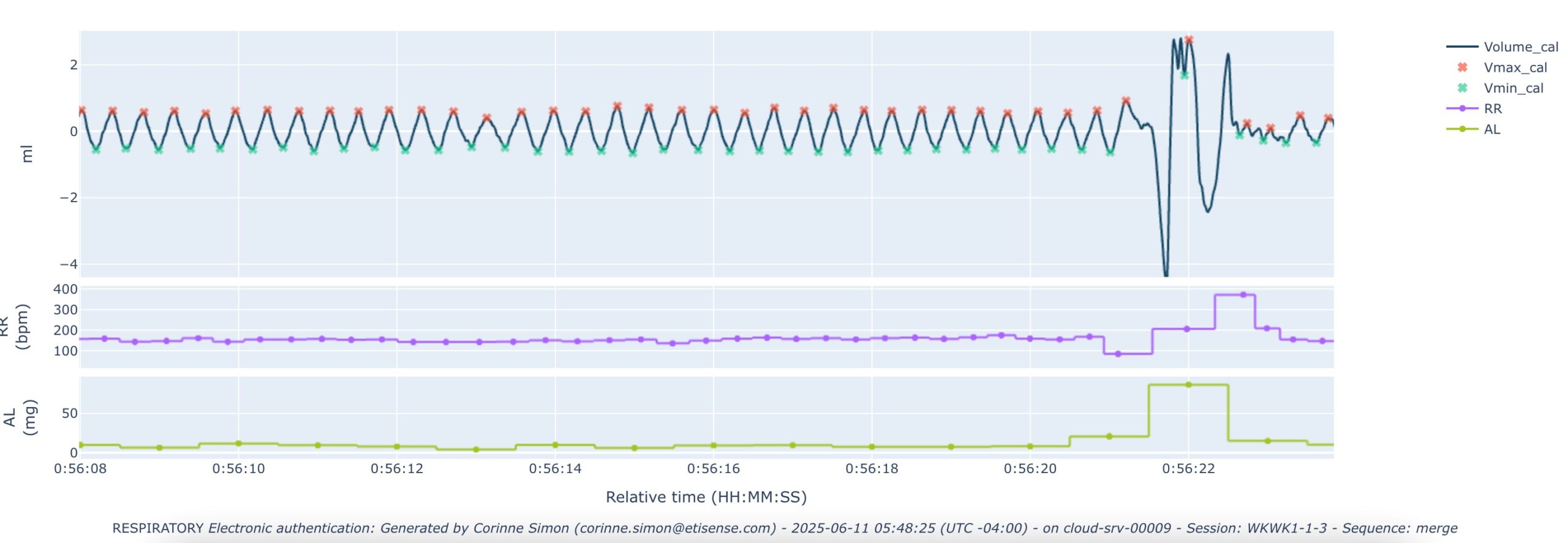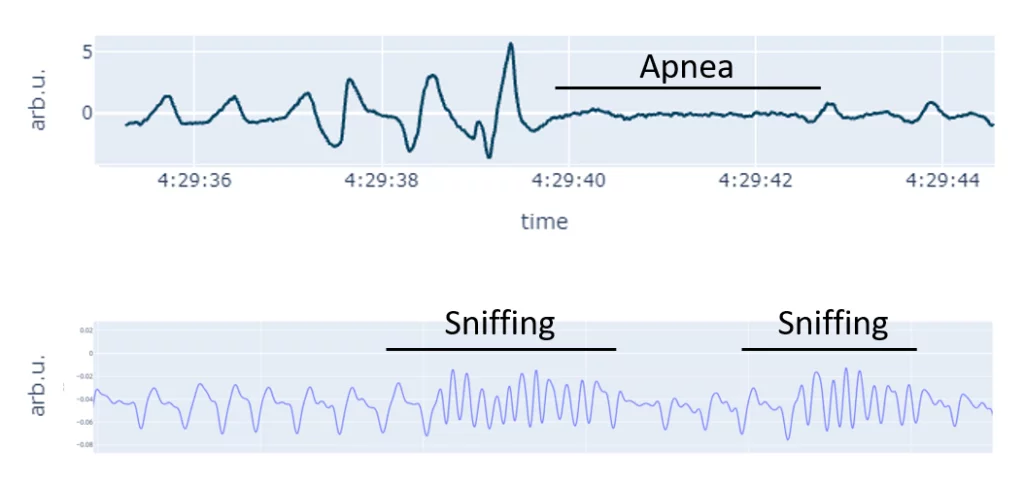Physiological Software:
Explore ECG, Plethysmography & Activity Modules
Beyond acquisition and visualization, the DECRO software includes a set of analyzer modules that extract meaningful physiological parameters from the recorded signals. These modules integrate plethysmography-based measurements, combining cardiorespiratory cycles detection algorithms, artifact detection algorithms, and advanced data processing to transform raw signals into exploitable scientific insights.
Advanced ECG Monitoring & Analysis – No Surgery, No Compromise
As a key component of the DECRO wearable telemetry solution, the ECG module offers high-fidelity cardiac monitoring without invasive procedures. Using surface electrodes positioned under the jacket — either on sheared fur for small animals or directly sewn into the fabric to be used without shaving for larger species — DECRO delivers continuous, high-resolution ECG recordings (24-bit, 500 Hz), all while animals remain freely moving and group-housed. The software includes powerful ECG analysis capabilities, combining both cardiac cycle detection and advanced waveform interpretation into a single, integrated workflow. Thanks to robust signal processing algorithms, researchers can rely on accurate and noise-resistant ECG analysis validated across multiple species.
Key Features of the ECG Analysis Module
Automatic detection of R-peaks and QRS complexes
Reliable positioning of QRS complexes and artifacts exclusion to ensure accurate calculation of heart rate, R-R intervals, and signal quality score.
Waveform delineation and fiducial point detection
Identification of P, Q, R, S, and T waves based on models, with configurable start/end localization.
Automatic calculation of intervals and segments
PR, QRS, QT, ST intervals and segments, with several QT correction methods.
Advanced signal processing
Averaging algorithms for noise reduction and probabilistic approaches for accurate delineation.
Visualization tools
Includes 3D waterfall views, QT/RR plots, overlay of averaged waveforms, and beat-to-beat raw signal inspection with manual correction capabilities via the editing mode.
Customizable settings
Preconfigured for available species such as rats and dogs, with the option to fine-tune parameters for specific needs — particularly when studying pathological animal models that require more precise evaluation.
Signal quality tracking
Detection score indicating the percentage of signal considered as valid.
Respiratory Monitoring & Analysis
DECRO integrates Respiratory Inductive Plethysmography (RIP) sensors directly sewn into the jacket (no floating belts), positioned around the thorax and abdomen to capture breathing-related volume changes. This allows for continuous, real-time respiratory monitoring in freely moving and socially housed animals, without restraint or confinement.
RIP offers a modern, animal-friendly alternative to traditional plethysmography chambers for small mammals and is the gold standard in large animals, allowing the collection of real-life respiratory data for periods of up to 24 to 48 hours. The RIP analyzer module automatically detects respiratory cycles,events and artifacts in order to accurately calculates detailed volume- and flow-based parameters. Calibration can be performed either manually or automatically through allometric approach (based on the weight), ensuring flexibility across species and experimental setups.
Key Features of the RIP Analysis Module
Automatic detection of respiratory events
End of inspiration, end of expiration, complete respiratory cycles.
Cycle-to-cycle parameter calculation
Respiratory cycle time, rate (bpm), tidal volume, inspiratory/expiratory durations and ratio.
Minute ventilation metrics
Minute volume in absolute or arbitrary units.
Flow analysis
Peak inspiratory and expiratory flow.
Signal quality tracking
Detection score indicating the percentage of signal successfully analyzed.
Flexible calibration
Allometric and manual scaling options for species-specific adaptation.
Activity Monitoring & Analysis
DECRO includes an Activity Analyzer Module that leverages accelerometry to quantify movement in real time. The embedded 3-axis accelerometer measures body acceleration, enabling the assessment of spontaneous or forced activity in various experimental conditions — from home cages to treadmills.
By integrating activity metrics into physiological recordings, researchers can contextualize biological responses and gain deeper insight into behavioral patterns. Activity data can help distinguish between drug effects and arousal, identify changes in circadian rhythms, or estimate energy expenditure — offering a valuable layer of interpretation.
Key Features of the Activity Analyzer Module
Tracking the intensity of movement
The system computes the OBDA-based Activity Index (mg) from 3D accelerometry, providing a continuous, quantitative measure of movement intensity.
Spontaneous behavior analysis
Detection of active vs. inactive periods to study chronobiology and behavioral trends. Can be coupled with video tracking.
Contextual interpretation of physiological signals
Relate changes in heart rate or respiration to movement or rest.
Energy expenditure estimation
Support for EEA (Estimated Energy for Activity) as a proxy for caloric output.
Smart data filtering
Use activity thresholds to exclude or focus on relevant signal segments.
Curious about what we’re really measuring with DECRO®?
Discover the science behind spontaneous activity tracking in our article.
From ECG to activity – find the setup that fits your study
Key Publications on DECRO Use Cases
Intérêt de la surveillance cardiorespiratoire non invasive chez le rat pour le raffinement de protocoles chirurgicaux
Intérêt de la surveillance cardiorespiratoire non invasive chez le rat pour le raffinement de protocoles chirurgicauxCambier A.1,2, Tanguy S.1, Flenet T.2, Boucher F.1 ¹ PRETA TIMC-IMAG, Université Grenoble Alpes, La Tronche² ETISENSE, Lyon, France 47th AFSTAL...
Evaluation of jacketed telemetry in rats for cardiorespiratory phenotyping at exercise
Evaluation of jacketed telemetry in rats for cardiorespiratory phenotyping at exerciseT. Flenet1 ; S. Tanguy2 ; A. Cambier1,2 ; E. Charles1 ; F. Boucher2 ¹ Biomedical engineering, ETISENSE SAS, Lyon, France; ² CNRS, timc-imag umr 5525, Université Grenoble Alpes,...
Simultaneous assessment of central nervous and respiratory systems using jacketed telemetry in socially-housed rats: Application of the “3Rs” principles in core battery safety pharmacology studies
Simultaneous assessment of central nervous and respiratory systems using jacketed telemetry in socially-housed rats: Application of the “3Rs” principles in core battery safety pharmacology studiesR. Fares & P. Champeroux, ERBC FOB test and respiratory study in the...
Jacketed Telemetry in Rats: Non-invasive Method for Refinement of Cardiorespiratory Monitoring During Exercise
Jacketed Telemetry in Rats: Non-invasive Method for Refinement of Cardiorespiratory Monitoring During ExerciseA Cambier1,2, S Tanguy1, C Eynard2, T Flenet2, F Boucher1 ¹ TIMC, Physiologie cardio-Respiratoire Expérimentale Théorique et Appliquée, University of...








